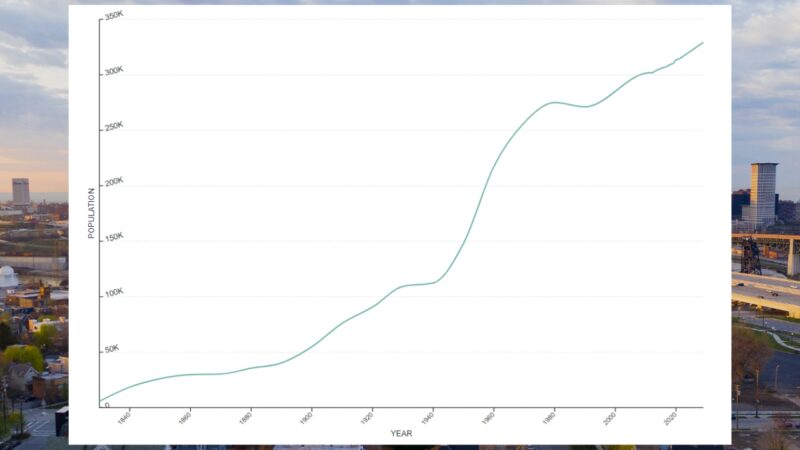Ohio, a vital state in the heart of the Midwest, exhibits a wide spectrum of demographic trends across its counties.
With data sourced from the U.S. Census Bureau and supplemented by various demographic surveys, we provide a detailed analysis of the factors contributing to the population changes in these key regions.
The insights herein reflect Ohio’s evolving urban landscapes and economic development, offering a comprehensive overview of the state’s demographic landscape.
As Ohio prepares for the 2024 voting schedule, this article will show you the population dynamics of Ohio counties as of 2024, highlighting their growth patterns, economic drivers, and cultural significance.
Population Trends
Ohio counties has seen varied demographic shifts over the decades. Franklin County, home to Columbus, has shown consistent growth, with its population reaching 1,322,300 in 2022 according to the Census Data. This represents a 12.35% increase since the last census. Cuyahoga County, where Cleveland is located, follows closely with 1,243,857 residents.
Hamilton County, hosting Cincinnati, has been growing steadily, now housing approximately 827,671 people as per datausa.
Other populous counties like Summit (Akron) have also seen fluctuations, with significant periods of growth and decline, reflecting broader national trends of urbanization and migration.
Top 10 Most Populous Counties
1. Franklin County

Franklin County, encompassing Columbus, is the most populous county in Ohio. With a population of approximately 1,323,807 residents in 2024, it ranks first in the state.
The county has seen significant growth, driven largely by urban development and economic opportunities in Columbus.
Major industries include education, healthcare, government, and finance. The Ohio State University, located in Columbus, is a significant educational and cultural hub. The county’s population growth has exceeded 12% since the last census.
2. Cuyahoga County
Cuyahoga County, home to Cleveland, ranks second with a population of around 1,233,088.
The county is well-known for its rich industrial history and vibrant cultural scene. Cleveland’s healthcare sector, led by the Cleveland Clinic, is a major economic driver.
The county has diverse neighborhoods, significant waterfront developments along Lake Erie, and numerous cultural institutions such as the Rock & Roll Hall of Fame. Population trends indicate a stable but slight decrease over recent years.
3. Hamilton County

Hamilton County, which includes Cincinnati, is the third most populous county with about 830,639 residents.
Known for its historical architecture and strong arts community, Cincinnati is a cultural and economic hub. Key industries include manufacturing, finance, and professional services.
The county also features numerous parks, the Cincinnati Zoo, and major sports teams like the Cincinnati Reds. Economic development initiatives in the county aim to attract new businesses and residents.
4. Summit County
Summit County, featuring Akron, has a population of approximately 539,853 says datausa.com.
Historically known as the “Rubber Capital of the World,” Akron continues to be an important economic center with evolving industries in healthcare, education, and technology.
The county is also home to the University of Akron. Summit’s scenic areas include the Cuyahoga Valley National Park, which attracts tourists and nature enthusiasts year-round.
5. Montgomery County

With Dayton as its county seat, Montgomery County has roughly 537,309 residents.
Dayton’s significant contributions to aviation and military technology underscore the county’s historical importance.
The county boasts several higher education institutions, including Wright State University and the University of Dayton.
Major industries are aerospace, healthcare, and logistics. Efforts to revitalize downtown Dayton have been ongoing, promoting growth and community engagement.
6. Lucas County
Lucas County, where Toledo is located, has a population of approximately 425,484. as per Ohio demographics.
Positioned on the western end of Lake Erie, Toledo’s economy thrives on its historical sectors of glass production, automotive parts, and shipping.
The city is known for its university, the University of Toledo, and its culturally rich Toledo Museum of Art.
The county continues to develop its waterfront areas and promote economic diversification.
7. Stark County
Stark County, with Canton as the county seat, accommodates around 374,853 residents.
Known for the Pro Football Hall of Fame, Canton brings significant tourism to the area. The county’s industries include manufacturing, healthcare, education, and retail.
The presence of institutions like Kent State University at Stark provides educational opportunities. Stark County’s economy remains diverse, maintaining steady growth and employment rates.
8. Butler County
Butler County, including cities like Hamilton and Middletown, has a population of about 396,358 according to World Population Review.
It is part of the Cincinnati metropolitan area, benefiting from its economic activities.
Major sectors include manufacturing, healthcare, and higher education, with Miami University located in Oxford.
Butler County offers suburban living with close proximity to Cincinnati, attracting families and professionals.
9. Lorain County

Lorain County, with Elyria and Lorain as key cities, hosts about 314,991 residents. Positioned along Lake Erie, the county has a mix of urban and rural environments.
The economy is bolstered by manufacturing, healthcare, and education, with Lorain County Community College being a significant institution.
Waterfront redevelopment projects and park expansions are a focus for continued growth in the area.
10. Mahoning County
Mahoning County, centered around Youngstown, has approximately 228,572 residents as per census.gov.
Historically an industrial and steel production hub, the county is transitioning towards sectors like healthcare, education, and technology.
Youngstown State University plays a crucial role here. Urban renewal and economic diversification initiatives are helping to rejuvenate the county, aiming to retain and attract a skilled workforce.
Methodology

Ohio counties’ data on population is primarily gathered through the decennial census conducted by the U.S. Census Bureau. In addition to the census, annual estimates and surveys provide updates to track changes more frequently. These include methods like the American Community Survey (ACS), which samples a percentage of the population annually to collect detailed demographic, social, and economic data.
Technological advancements have improved the accuracy and efficiency of data collection. Combining administrative records, remote sensing, and Geographic Information System (GIS) technology, authorities can effectively monitor population dynamics. The integration of various data sources ensures more reliable and comprehensive demographic insights.
The ranking is determined by several key metrics. The primary factor is the total population of each county as of 2024. Growth rates since the last census play a significant role, showcasing areas of increasing population.
Additional factors include population density, urbanization, and economic indicators. Counties with large metropolitan areas, like Franklin and Cuyahoga, often rank higher due to their substantial urban populations.
Metrics Used
- Total Population
- Population Growth Rate
- Urbanization Level
- Economic Indicators
The methodology ensures a balanced look at both current size and dynamic growth patterns, providing a comprehensive view of Ohio’s most populous counties.

